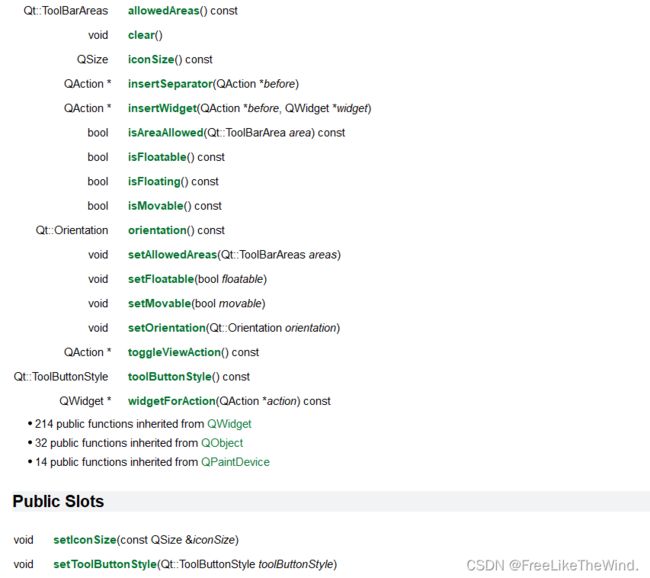Qt之菜单栏、工具栏、状态栏介绍及工具栏QAction的动态增删显示实现方式
目的
端应用程序或者编辑器基本都支持工具栏快捷功能的动态增删,即通过在菜单栏上打钩就可以在工具栏上看到相应功能的快捷按钮,取消打钩则在工具栏上就移除了该功能的快捷按钮。那么Qt如何实现这个功能,本篇目的就是记录实现此功能的方法及思路。
效果
先看下动态效果:
菜单栏动态添加动作到工具栏
介绍
首先,说下菜单栏,工具栏和状态栏区别:
- 菜单栏:一般在窗体标题的下方,有下拉选项,和可有多级子菜单。
- 工具栏:一般在菜单栏下方,可上下左右四个方向调整位置,默认在菜单栏下方(即上方向),方便操作,直接点击即可触发想要的工作。
- 状态栏:一般在窗体最下方,用于永久或者暂时显示某些状态信息等。
Qt之QMenuBar(菜单栏)、QToolBar(工具栏)、QStatusBar(状态栏)操作说明
可在帮助里,选择索引,输入想查找的类,比如qmenubar,一般选择第一个结果(可根据需要选择其他),会弹出选择主题,选择库版本,会跳到对应的类介绍页

点击More...,会跳到Detailed Description,查看此类详细介绍,或者点击Public Functions查看此类公有成员方法。
QMenuBar(菜单栏)
QStatusBar(状态栏)
QToolBar(工具栏)
菜单栏对工具栏进行动作动态配置的实现思路
- 首先,菜单栏的子菜单和动作是已知并存在的
- 动作设置为可选择的
- 当点击动作时,触发
triggered(bool checked)信号 - 绑定槽,然后根据
checked状态,进行工具栏动态创建动作或者移除动作 - 当点击工具栏动作时,触发动作实际功能
示例
mainwindow.h
#ifndef MAINWINDOW_H
#define MAINWINDOW_H
#include mainwindow.cpp
#include "mainwindow.h"
#include "ui_mainwindow.h"
#include ui
// ui的话,主要是添加一些菜单和动作,工具栏是代码实现的
// 动作名称
main.cpp
#include "mainwindow.h"
#include 分析
以上示例,主要函数为:
private:
void setAction(QToolBar* pTB, QAction* pActSender, bool checked);
void MainWindow::setAction(QToolBar *pTB, QAction *pActSender, bool checked)
{
if(checked){
foreach (QAction* pAct, pTB->actions()) {
if(pAct->text().compare(pActSender->text()) == 0)
{
return;
}
}
QAction* pActClone = new QAction(pActSender->text(), this);
connect(pActClone, &QAction::triggered, this, [this, pActClone](){
ui->statusBar->showMessage(QString("我是 %1").arg(pActClone->text()), 2000);
QMessageBox::information(this, "提示", QString("我是 %1").arg(pActClone->text()));
});
pTB->insertAction(0, pActClone);
}
else {
foreach (QAction* pAct, pTB->actions()) {
if(pAct->text().compare(pActSender->text()) == 0)
{
pTB->removeAction(pAct);
return;
}
}
}
}
根据传入的参数,进行工具栏动态的创建。
此外:
ui->statusBar->showMessage(QString("我是 %1").arg(pActClone->text()), 2000);
上述代码是 暂时显示文本,时间是2000ms,之后会消失。
结论
学以致用。





